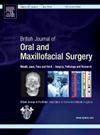副腮腺肿瘤与腮腺和下颌腺肿瘤的临床、组织病理学和流行病学特征:基于波兰唾液网络数据库2653例的观察。
IF 1.9
4区 医学
Q3 DENTISTRY, ORAL SURGERY & MEDICINE
British Journal of Oral & Maxillofacial Surgery
Pub Date : 2025-07-01
DOI:10.1016/j.bjoms.2024.09.014
引用次数: 0
摘要
唾液腺肿瘤是口腔病理中最复杂和罕见的异质性病变之一。大型临床和基于人群的流行病学研究本质上是有限的。这项多中心前瞻性研究于2017年至2021年期间使用波兰唾液网络数据库(PSND)进行。分析了2653例唾液腺肿瘤的数据集,重点分析了下颌下腺(n = 173)、副腮腺(n = 100)和腮腺(n = 2375)。流行病学和病理因素被认为是确定恶性肿瘤的风险和差异的下颌骨,腮腺和副腮腺肿瘤。与腮腺肿瘤患者(60.0岁)相比,下颌骨肿瘤患者(50.5岁)和副腮腺肿瘤患者(51.5岁)的中位年龄有显著差异(p本文章由计算机程序翻译,如有差异,请以英文原文为准。
Clinical, histopathological, and epidemiological characterisation of accessory parotid gland tumours in relation to parotid and submandibular gland tumours: observations based on 2653 cases of the Polish Salivary Network Database
Salivary gland tumours comprise one of the most complex and rare groups of heterogeneous lesions encountered in oral pathology. Large clinical and population-based epidemiological studies are inherently limited. This multicentre prospective study was conducted between 2017 and 2021 using the Polish Salivary Network Database (PSND). A dataset of 2653 cases of salivary gland tumours was analysed, focusing on the submandibular gland (n = 173), accessory parotid gland (n = 100), and parotid gland (n = 2375). Epidemiological and pathological factors were considered to identify the risk of malignancy and differences between tumours of the submandibular, parotid, and accessory parotid glands. A significant difference was observed in the median age of patients with tumours of the submandibular (50.5 years) and accessory parotid glands (51.5 years) compared with that of patients with parotid gland tumours (60.0 years) (p < 0.001). Factors such as tobacco usage (p < 0.001) and place of residence (p = 0.015) were associated with these differences. Sex was not a differentiating factor in the risk of malignancy. In females, 106/173 patients had tumours in the submandibular gland, 61/100 had tumours in the accessory parotid, and 1282/2375 had tumours in the parotid. In males, 67/173 had tumours in the submandibular gland, 39/100 had tumours in the accessory parotid, and 1093/2375 had tumours in the parotid. Significant differences were found in submandibular and parotid tumour locations between village and city inhabitants (p = 0.016). The nature of tumours located in the parotid, comprising the superficial and deep lobes, was distinct in relation to accessory parotid tumours. Accessory parotid tumours exhibited more similarities to those originating in the submandibular region. These findings have the potential to impact future clinical approaches. However, additional validation studies are needed.
求助全文
通过发布文献求助,成功后即可免费获取论文全文。
去求助
来源期刊
CiteScore
3.60
自引率
16.70%
发文量
256
审稿时长
6 months
期刊介绍:
Journal of the British Association of Oral and Maxillofacial Surgeons:
• Leading articles on all aspects of surgery in the oro-facial and head and neck region
• One of the largest circulations of any international journal in this field
• Dedicated to enhancing surgical expertise.

 求助内容:
求助内容: 应助结果提醒方式:
应助结果提醒方式:


